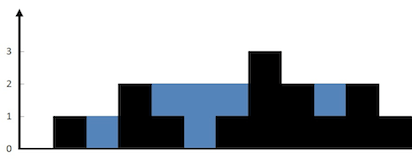How to Efficiently Solve the Trapping Rain Water Problem
This article will resolve
| LeetCode | Difficulty |
|---|---|
| 11. Container With Most Water | 🟠 |
| 42. Trapping Rain Water | 🔴 |
LeetCode Problem 42 "Trapping Rain Water" is interesting and often appears in interviews. This article will explain how to optimize the solution step by step.
Here is the problem:
42. Trapping Rain Water | LeetCode | 🔴
Given n non-negative integers representing an elevation map where the width of each bar is 1, compute how much water it can trap after raining.
Example 1:

Input: height = [0,1,0,2,1,0,1,3,2,1,2,1] Output: 6 Explanation: The above elevation map (black section) is represented by array [0,1,0,2,1,0,1,3,2,1,2,1]. In this case, 6 units of rain water (blue section) are being trapped.
Example 2:
Input: height = [4,2,0,3,2,5] Output: 9
Constraints:
n == height.length1 <= n <= 2 * 1040 <= height[i] <= 105
You are given an array representing a bar chart. The question asks how much water can be trapped by the bars after raining.
int trap(int[] height);int trap(vector<int>& height);def trap(height: List[int]) -> int:func trap(height []int) int {}var trap = function(height) {}Next, I will introduce three methods from simple to advanced: brute-force solution -> memoization solution -> two pointers solution. We will solve this problem in O(N) time and O(1) space.
1. Core Idea
Quick Tip
When solving algorithm problems, if you have no idea how to start, try to simplify the problem. Think about a small part first and write the simplest brute-force solution. You might find a key point and then optimize step by step to reach the best solution.
For this problem, let's not think about the whole bar chart first. Just think about how much water can be trapped at position i?

At position i, we can trap 2 units of water. This is because height[i] is 0, and the highest possible water level here is 2. So, 2 - 0 = 2.
Why can position i hold up to 2 units of water? It depends on the tallest bar to the left and the tallest bar to the right of position i. Let's call these heights l_max and r_max. The highest water level at position i is min(l_max, r_max).
So, for position i, the amount of water trapped is: